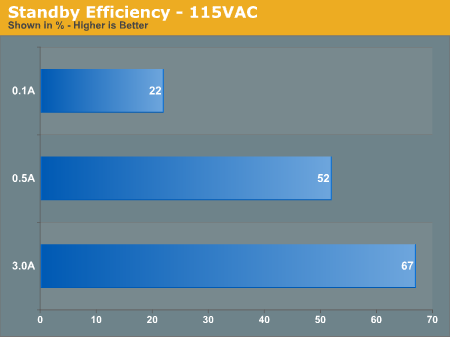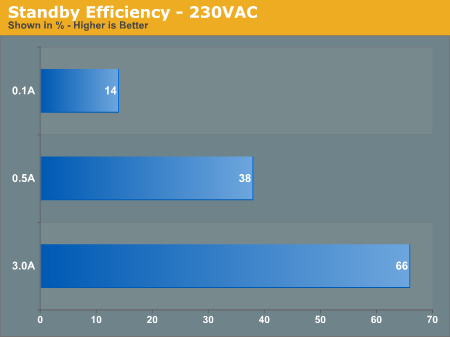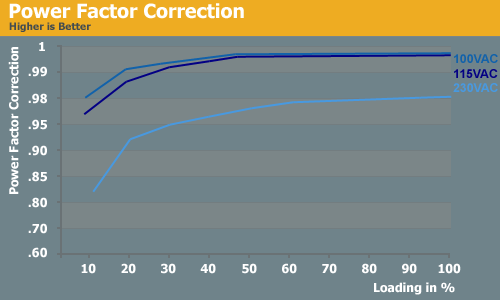Zippy Gaming G1 (GSM-6600P): Hybrid or Fence-Sitter?
by Christoph Katzer on August 3, 2007 2:30 AM EST- Posted in
- Cases/Cooling/PSUs
Standby Efficiency


We do see minor flaws on the Zippy in terms of standby efficiency. With no load on any rail but 5Vsb we measured a power usage of 1.79W with 115VAC and a total of 3.5W at 230VAC. These amounts are quite high and this is an area that could definitely use more attention in the future. The standby efficiency itself could also use work; at just 14%-22% efficiency at low loads it is a very bad result indeed. If you leave your system on all the time, of course, this may not be much of a concern.
Efficiency

The overall efficiency is quite average and doesn't reach the level of any of our formerly tested units other than the Enermax Liberty, which it matches. This might come from the fact that for servers, high efficiency is often a secondary concern next to reliability. As we have seen already the standby efficiency is low (servers are almost never shut off) so we are not surprised to see these average results in overall efficiency.
PFC

The power factor correction with lower input voltages is very good. We have seen a big difference between the 100-115VAC and 230VAC with all of the power supplies so far, and PFC could certainly be improved with higher input voltages.


We do see minor flaws on the Zippy in terms of standby efficiency. With no load on any rail but 5Vsb we measured a power usage of 1.79W with 115VAC and a total of 3.5W at 230VAC. These amounts are quite high and this is an area that could definitely use more attention in the future. The standby efficiency itself could also use work; at just 14%-22% efficiency at low loads it is a very bad result indeed. If you leave your system on all the time, of course, this may not be much of a concern.
Efficiency

The overall efficiency is quite average and doesn't reach the level of any of our formerly tested units other than the Enermax Liberty, which it matches. This might come from the fact that for servers, high efficiency is often a secondary concern next to reliability. As we have seen already the standby efficiency is low (servers are almost never shut off) so we are not surprised to see these average results in overall efficiency.
PFC

The power factor correction with lower input voltages is very good. We have seen a big difference between the 100-115VAC and 230VAC with all of the power supplies so far, and PFC could certainly be improved with higher input voltages.










16 Comments
View All Comments
crimson117 - Monday, August 6, 2007 - link
The last two paragraphs in the Conclusion are in italics.http://www.anandtech.com/casecoolingpsus/showdoc.a...">http://www.anandtech.com/casecoolingpsus/showdoc.a...
JarredWalton - Monday, August 6, 2007 - link
Sorry - fixed now. Missed the closing > of the "turn off italics" tag. That's what I get for inserting a quick comment after posting. :|irev210 - Saturday, August 4, 2007 - link
From a build-quality standpoint... it is hard to find another PSU that can touch these.I hope that anandtech looks at more zippy units.
lopri - Saturday, August 4, 2007 - link
I, like many others, am loving the new PSU review series from AT. The articles so far are superb and full of good information, and best of all is that the information is largely based on the end-users' point of view. I'd like to thank AT for these reviews. Keep up the good work!Duraz0rz - Friday, August 3, 2007 - link
Are there no separate graphs for different ambient temperatures anymore? On page 5, you say you test for two different temperatures: 25C and 50C, but I only see one graph per rail and I have no clue which temperature that is for. You do mention in one of your paragraphs about Zippy being worried about testing @ 50C, so I'm confused.Nice review, nevertheless, but like you said, it is a little expensive.
JarredWalton - Friday, August 3, 2007 - link
The second graph (with higher temperatures) starts at 25C and ramps up to 50C by 100% load - just like in previous PSU reviews. Note the subtitle on the first temp graph - "Tested at Room Temperature".Duraz0rz - Friday, August 3, 2007 - link
That's the thing...there's only one graph per rail on page 5.JarredWalton - Friday, August 3, 2007 - link
The 230VAC-Room is done at room temperature (25-26C). It's present on all the charts except for the 5vsb (where it really doesn't matter much). We combined all four results into one chart because that seemed to be more useful for comparing the results and condensing the article into 8 pages instead of 22. :)Super Nade - Friday, August 3, 2007 - link
You won't recommend it for overclocking or a rig with a quad-core CPU? Why? Very strange conclusion after stating that it regulates like no other. Would a real enthusiast care about noise or the 5VSB and standby efficiency when breaking records or pushing the envelope of his machine?"In most other areas, it unfortunately falls short."
Apart from the electrical characteristics does the "failure" in "other" areas really matter?
JarredWalton - Friday, August 3, 2007 - link
This statement has been edited for clarity. Overclocking on it's own isn't a problem, and neither are quad cores or (certain) dual GPU configurations - don't try dual HD 2900 XT, most likely, since besides two PEG connections per card they can also use an 8-pin PEG as one of the connections. You can basically do two of the items in that list, but if you try to do all three you're going to go WAY over 600W.8800 GTX SLI (using factory OC'ed models) and Q6600/6700 @ ~3.47 GHz with two or three hard drives and idle power use will be in the neighborhood of 400-450W. Load up the CPU (say, Folding@Home SMP) and you can easily hit 600W or more. Play some games that load up the GPUs, and you really ought to be running a 1000W PSU - assuming maximum efficiency as usual comes in the 50-80% load range.
It falls short in noise, cooling performance, connections for certain devices. As an enthusiast, I definitely don't want a PSU that cranks out that much noise, considering there are other PSUs (SeaSonic) that will match the Zippy in all other ways and do it at lower noise levels.